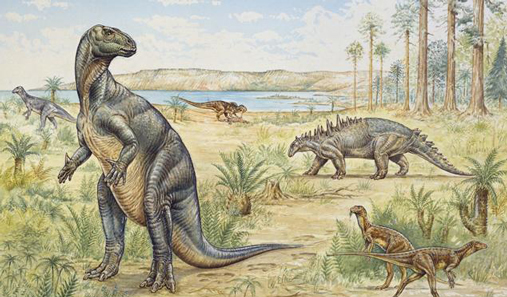Oldest Pine Fossils Reveal Link with Firestorms as New Paper is Published
Oldest Pine Tree Fossils Described
A pine tree is such a familiar object that it hardly deserves a second glance. Walking in the park, driving into work, many people will pass these ubiquitous trees without giving them a thought. Pine trees are also found in gardens, if you are mowing the lawn this weekend, stop for a moment and nod your head towards your pine as these types of tree originated at least 140 million years ago. In addition, pine trees that dominate much of the Northern Hemisphere today might owe their success, if not their very existence to a fiery past.
Oldest Pine Fossils
Pine Trees Once Overlooked Dinosaurs
Picture credit: Natural History Museum (London)
The pine trees (Pinaceae) are a very diverse conifer genus these days, there are something like 115 species known today. They are renowned for their ability to retain water thanks to their tough needles and their adaptations that help them withstand forest fires. They contain highly flammable deadwood that burns very easily.
Pine Trees are Inflammable
Conifers produce terpenes, which are highly combustible organic compounds, it is these compounds that make pine trees so inflammable. They also produce cones that will only germinate in many cases after being scorched by fire. A new generation of pine trees can then emerge, using the nutrient rich ash left by a forest fire to sustain them and without much competition from other plants as these would have been destroyed by the conflagration.
A team of scientists from the Department of Earth Sciences at Royal Holloway (University of London), have found the oldest fossil evidence of pine trees. The discovery was due to serendipity almost as much as hard work and dedicated research. Dr Howard Falcon-Lang discovered the fossils preserved as charcoal in a rock layer dated to the Valanginian faunal stage of the Cretaceous, approximately 133 to 140 million years ago. The tiny fragments of pine tree suggest that conifers co-evolved with fire at a time when atmospheric oxygen levels were much higher than today, making forest fires much more likely and intense.
A False Colour Image of a Pine Tree Fragment Preserved as Charcoal
Picture credit: Royal Holloway, University of London.
A Significant Discovery
Commenting on the significance of the fossil find, Dr Falcon-Lang stated:
“Pines are well adapted to fire today. The fossils show that wildfires raged through the earliest pine forests and probably shaped the evolution of this important tree. Modern pines store flammable resin-rich deadwood on the tree making them prone to lethal fires. However, they also produce huge numbers of cones that will only germinate after a fire, ensuring a new cohort of trees is seeded after the fire has passed by.”
A paper detailing the research has been published in the journal of the Geological Society of America. The fossils had been gathered several years ago and lay unexamined in a cupboard. It was only when the rock samples were subjected to acidification to digest the matrix material that the tiny fragments of tell-tale pine tree were revealed. Although each specimen is only a few millimetres in length they have been interpreted as being the remains of an evergreen two-needle pine.
The research is published in the journal Geological Society of America.



